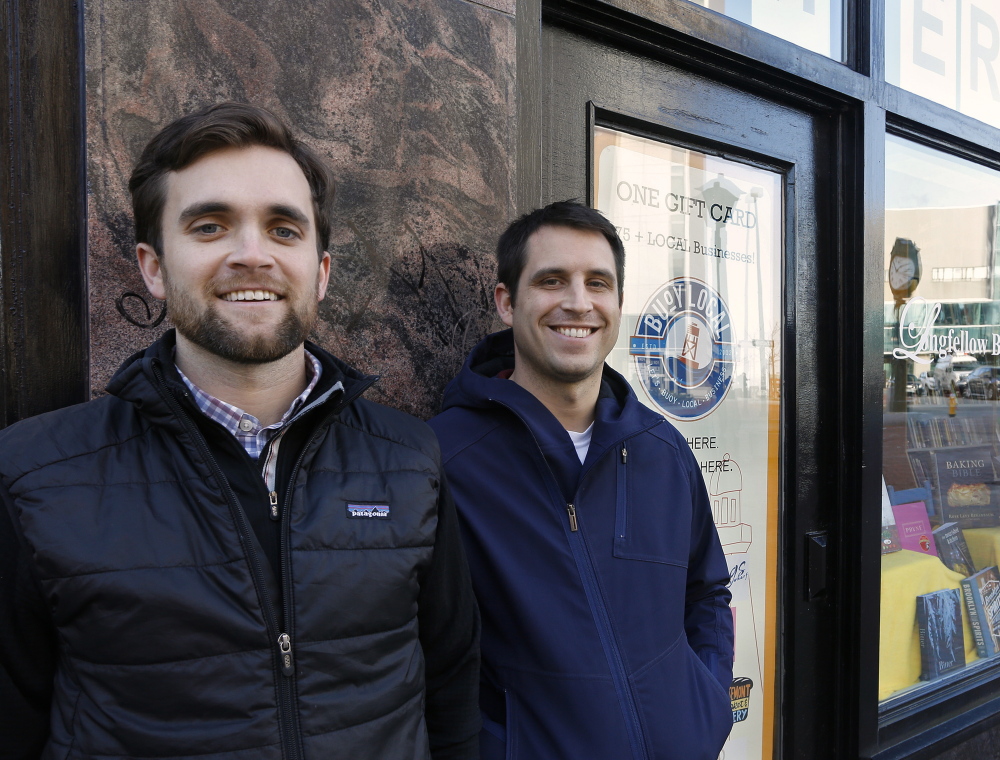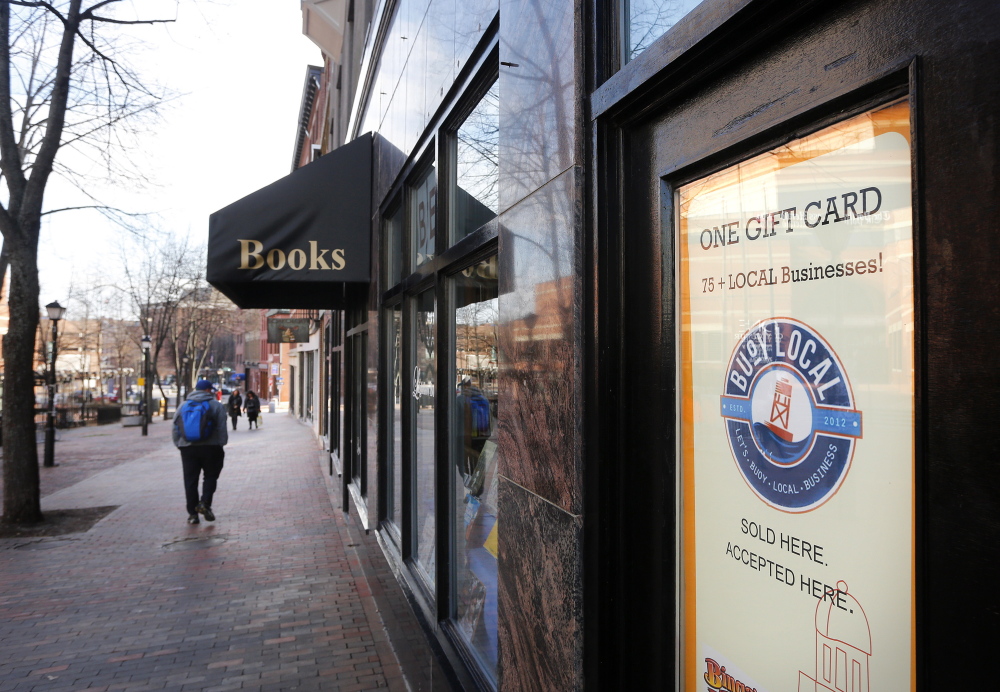Kai Smith and Sean Sullivan knew they had a good idea for a startup: create a gift card that could be redeemed at locally owned businesses.
The business model is pretty straightforward – merchants pay a fee to be members of Buoy Local network, and Smith and Sullivan promote them on social media, and through ads in local downtown guides and on posters, banners and various other channels.
The idea behind Buoy Local gift cards is to keep more dollars circulating in Maine’s economy, part of a burgeoning buy-local movement. Redeeming the cards means consumers drive sales to local merchants that might otherwise go to national retailers. And the Buoy Local team promotes small businesses at a much lower price than they would pay for advertising on TV, radio or the Internet.
They also knew that the buy-local market in Portland had already been primed. Portland Buy Local, an unrelated nonprofit group launched in 2006, was already well established, promoting support of home-grown businesses. Its “Buy Local Keep Portland Independent” stickers are ubiquitous in the windows of shops throughout town.
But there is a huge difference between having a good idea and launching a viable business strategy.
Smith and Sullivan knew they needed at least $300 from each business to cover their costs. How could they convince small-business owners that a $300 investment in the Buoy Local network would actually pay off?
“Getting people to buy into a concept was really hard,” said Smith, 29, an MBA student at the University of Southern Maine. “We had to find a way to provide value.”
Some merchants were happy to jump aboard because they wanted to support the local economy and were familiar with a Maine Center for Economic Policy analysis which found that every $100 spent at locally owned businesses contributes an additional $58 to the local economy, compared to just $33 spent at a national chain.
But others were more reluctant to shell out hard-earned cash on a concept, especially when they had spent money advertising on other channels that hadn’t necessarily translated to sales.
STARTING A STARTUP
The duo first raised $4,560 through an Indiegogo crowd-funding campaign to cover some startup costs like payment processing and marketing. They created a video to explain who they are and what they do, and to answer frequently asked questions.
The startup got an early boost when larger, established local businesses came on board, like Coffee by Design and Longfellow Books, which served as anchor members and attracted smaller businesses.
But then national retailers with local stores wanted to join the network. Turning them down meant passing up potentially lucrative partnerships, said Smith. But the entrepreneurs had established rules – a member business has to be privately or cooperatively owned, and at least 50 percent locally owned, operate in a limited geographic range, and contribute to the cultural and economic fabric of the region.
“We had to stick to our guns, with regards to the stated mission,” said Smith. “Our business loses its authenticity if we don’t.”
The pair was able to expand the network to 80 businesses by showing that the Buoy Local program was paying off for its members.
They achieved this by providing quarterly reports to Buoy Local businesses that show spending trends at their stores, including the time and day each card was redeemed, average transaction value, and the total spent at their business, in relation to other spending in town.
The information is proprietary – one merchant can’t tell what’s being spent at a competitor’s. But they can see how they compare to their peers who are selling comparable goods, or other peers in their area. That information can offer valuable perspective on sales trends to merchants who might not have the resources to gather it themselves. “They know down to the cent what their return on investment is,” said Smith.
The data has been essential in getting members to pay the $200 one-time fee to join, and the $100 annual dues.
Beyond the quarterly sales reports, Smith and Sullivan also tout their sales milestones every chance they get, on social media and through other channels. A ticker on the Buoy Local website shows how much has been spent via Buoy Local.
“We want people to know what the impact is, and that they’re part of something larger that they can feel good about,” said Smith.
Going forward, the duo are tinkering with their fee structure to ensure there’s an appropriate match with the value that a member receives.
And they’re eager to get the word out, so more businesses join the network, and more consumers purchase the cards. This year they plan to make their first ad buys, which include a spot on the Maine Public Broadcasting Network and another on the back of Portland city buses.
“Ultimately it’s about driving spending to local independent businesses, not just because it feels good but because it makes sense economically,” Sullivan said. “It accelerates economic growth, and helps maintain authenticity and uniqueness to the region and creates businesses that are positioned to meet unique needs of local people, and make this a great place to live.”
Send questions/comments to the editors.




Comments are no longer available on this story